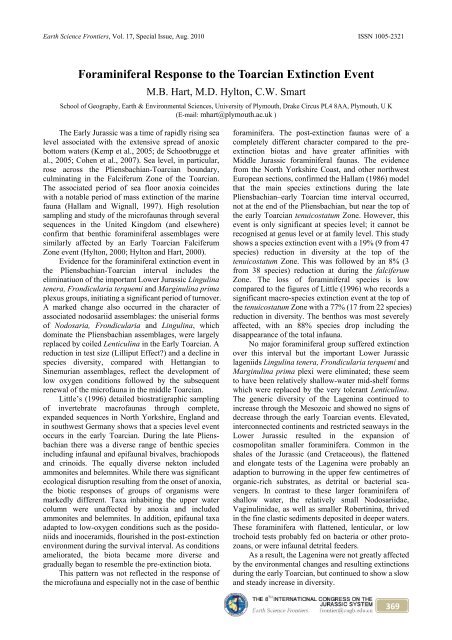in Jurassic and Cretaceous Stratigraphy
in Jurassic and Cretaceous Stratigraphy
in Jurassic and Cretaceous Stratigraphy
Create successful ePaper yourself
Turn your PDF publications into a flip-book with our unique Google optimized e-Paper software.
Earth Science Frontiers, Vol. 17, Special Issue, Aug. 2010 ISSN 1005-2321<br />
Foram<strong>in</strong>iferal Response to the Toarcian Ext<strong>in</strong>ction Event<br />
M.B. Hart, M.D. Hylton, C.W. Smart<br />
School of Geography, Earth & Environmental Sciences, University of Plymouth, Drake Circus PL4 8AA, Plymouth, U K<br />
(E-mail: mhart@plymouth.ac.uk )<br />
The Early <strong>Jurassic</strong> was a time of rapidly ris<strong>in</strong>g sea<br />
level associated with the extensive spread of anoxic<br />
bottom waters (Kemp et al., 2005; de Schootbrugge et<br />
al., 2005; Cohen et al., 2007). Sea level, <strong>in</strong> particular,<br />
rose across the Pliensbachian-Toarcian boundary,<br />
culm<strong>in</strong>at<strong>in</strong>g <strong>in</strong> the Falciferum Zone of the Toarcian.<br />
The associated period of sea floor anoxia co<strong>in</strong>cides<br />
with a notable period of mass ext<strong>in</strong>ction of the mar<strong>in</strong>e<br />
fauna (Hallam <strong>and</strong> Wignall, 1997). High resolution<br />
sampl<strong>in</strong>g <strong>and</strong> study of the microfaunas through several<br />
sequences <strong>in</strong> the United K<strong>in</strong>gdom (<strong>and</strong> elsewhere)<br />
confirm that benthic foram<strong>in</strong>iferal assemblages were<br />
similarly affected by an Early Toarcian Falciferum<br />
Zone event (Hylton, 2000; Hylton <strong>and</strong> Hart, 2000).<br />
Evidence for the foram<strong>in</strong>iferal ext<strong>in</strong>ction event <strong>in</strong><br />
the Pliensbachian-Toarcian <strong>in</strong>terval <strong>in</strong>cludes the<br />
elim<strong>in</strong>atiuon of the important Lower <strong>Jurassic</strong> L<strong>in</strong>gul<strong>in</strong>a<br />
tenera, Frondicularia terquemi <strong>and</strong> Marg<strong>in</strong>ul<strong>in</strong>a prima<br />
plexus groups, <strong>in</strong>itiat<strong>in</strong>g a significant period of turnover.<br />
A marked change also occurred <strong>in</strong> the character of<br />
associated nodosariid assemblages: the uniserial forms<br />
of Nodosaria, Frondicularia <strong>and</strong> L<strong>in</strong>gul<strong>in</strong>a, which<br />
dom<strong>in</strong>ate the Pliensbachian assemblages, were largely<br />
replaced by coiled Lenticul<strong>in</strong>a <strong>in</strong> the Early Toarcian. A<br />
reduction <strong>in</strong> test size (Lilliput Effect?) <strong>and</strong> a decl<strong>in</strong>e <strong>in</strong><br />
species diversity, compared with Hettangian to<br />
S<strong>in</strong>emurian assemblages, reflect the development of<br />
low oxygen conditions followed by the subsequent<br />
renewal of the microfauna <strong>in</strong> the middle Toarcian.<br />
Little’s (1996) detailed biostratigraphic sampl<strong>in</strong>g<br />
of <strong>in</strong>vertebrate macrofaunas through complete,<br />
exp<strong>and</strong>ed sequences <strong>in</strong> North Yorkshire, Engl<strong>and</strong> <strong>and</strong><br />
<strong>in</strong> southwest Germany shows that a species level event<br />
occurs <strong>in</strong> the early Toarcian. Dur<strong>in</strong>g the late Pliens-<br />
bachian there was a diverse range of benthic species<br />
<strong>in</strong>clud<strong>in</strong>g <strong>in</strong>faunal <strong>and</strong> epifaunal bivalves, brachiopods<br />
<strong>and</strong> cr<strong>in</strong>oids. The equally diverse nekton <strong>in</strong>cluded<br />
ammonites <strong>and</strong> belemnites. While there was significant<br />
ecological disruption result<strong>in</strong>g from the onset of anoxia,<br />
the biotic responses of groups of organisms were<br />
markedly different. Taxa <strong>in</strong>habit<strong>in</strong>g the upper water<br />
column were unaffected by anoxia <strong>and</strong> <strong>in</strong>cluded<br />
ammonites <strong>and</strong> belemnites. In addition, epifaunal taxa<br />
adapted to low-oxygen conditions such as the posido-<br />
niids <strong>and</strong> <strong>in</strong>oceramids, flourished <strong>in</strong> the post-ext<strong>in</strong>ction<br />
environment dur<strong>in</strong>g the survival <strong>in</strong>terval. As conditions<br />
ameliorated, the biota became more diverse <strong>and</strong><br />
gradually began to resemble the pre-ext<strong>in</strong>ction biota.<br />
This pattern was not reflected <strong>in</strong> the response of<br />
the microfauna <strong>and</strong> especially not <strong>in</strong> the case of benthic<br />
foram<strong>in</strong>ifera. The post-ext<strong>in</strong>ction faunas were of a<br />
completely different character compared to the pre-<br />
ext<strong>in</strong>ction biotas <strong>and</strong> have greater aff<strong>in</strong>ities with<br />
Middle <strong>Jurassic</strong> foram<strong>in</strong>iferal faunas. The evidence<br />
from the North Yorkshire Coast, <strong>and</strong> other northwest<br />
European sections, confirmed the Hallam (1986) model<br />
that the ma<strong>in</strong> species ext<strong>in</strong>ctions dur<strong>in</strong>g the late<br />
Pliensbachian–early Toarcian time <strong>in</strong>terval occurred,<br />
not at the end of the Pliensbachian, but near the top of<br />
the early Toarcian tenuicostatum Zone. However, this<br />
event is only significant at species level; it cannot be<br />
recognised at genus level or at family level. This study<br />
shows a species ext<strong>in</strong>ction event with a 19% (9 from 47<br />
species) reduction <strong>in</strong> diversity at the top of the<br />
tenuicostatum Zone. This was followed by an 8% (3<br />
from 38 species) reduction at dur<strong>in</strong>g the falciferum<br />
Zone. The loss of foram<strong>in</strong>iferal species is low<br />
compared to the figures of Little (1996) who records a<br />
significant macro-species ext<strong>in</strong>ction event at the top of<br />
the tenuicostatum Zone with a 77% (17 from 22 species)<br />
reduction <strong>in</strong> diversity. The benthos was most severely<br />
affected, with an 88% species drop <strong>in</strong>clud<strong>in</strong>g the<br />
disappearance of the total <strong>in</strong>fauna.<br />
No major foram<strong>in</strong>iferal group suffered ext<strong>in</strong>ction<br />
over this <strong>in</strong>terval but the important Lower <strong>Jurassic</strong><br />
lageniids L<strong>in</strong>gul<strong>in</strong>a tenera, Frondicularia terquemi <strong>and</strong><br />
Marg<strong>in</strong>ul<strong>in</strong>a prima plexi were elim<strong>in</strong>ated; these seem<br />
to have been relatively shallow-water mid-shelf forms<br />
which were replaced by the very tolerant Lenticul<strong>in</strong>a.<br />
The generic diversity of the Lagen<strong>in</strong>a cont<strong>in</strong>ued to<br />
<strong>in</strong>crease through the Mesozoic <strong>and</strong> showed no signs of<br />
decrease through the early Toarcian events. Elevated,<br />
<strong>in</strong>terconnected cont<strong>in</strong>ents <strong>and</strong> restricted seaways <strong>in</strong> the<br />
Lower <strong>Jurassic</strong> resulted <strong>in</strong> the expansion of<br />
cosmopolitan smaller foram<strong>in</strong>ifera. Common <strong>in</strong> the<br />
shales of the <strong>Jurassic</strong> (<strong>and</strong> <strong>Cretaceous</strong>), the flattened<br />
<strong>and</strong> elongate tests of the Lagen<strong>in</strong>a were probably an<br />
adaption to burrow<strong>in</strong>g <strong>in</strong> the upper few centimetres of<br />
organic-rich substrates, as detrital or bacterial sca-<br />
vengers. In contrast to these larger foram<strong>in</strong>ifera of<br />
shallow water, the relatively small Nodosariidae,<br />
Vag<strong>in</strong>ul<strong>in</strong>idae, as well as smaller Robert<strong>in</strong><strong>in</strong>a, thrived<br />
<strong>in</strong> the f<strong>in</strong>e clastic sediments deposited <strong>in</strong> deeper waters.<br />
These foram<strong>in</strong>ifera with flattened, lenticular, or low<br />
trochoid tests probably fed on bacteria or other proto-<br />
zoans, or were <strong>in</strong>faunal detrital feeders.<br />
As a result, the Lagen<strong>in</strong>a were not greatly affected<br />
by the environmental changes <strong>and</strong> result<strong>in</strong>g ext<strong>in</strong>ctions<br />
dur<strong>in</strong>g the early Toarcian, but cont<strong>in</strong>ued to show a slow<br />
<strong>and</strong> steady <strong>in</strong>crease <strong>in</strong> diversity.<br />
369

















